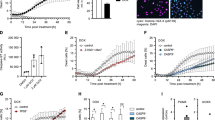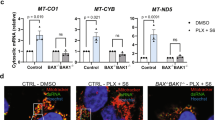Abstract
Over the past several years we have obtained considerable evidence indicating that adenoviruses-expressing interferon α (Ad-IFNα) can overcome resistance to the IFNα protein itself. Since cancer cells infected with Ad-IFNα also show high perinuclear cytoplasmic IFNα expression, we were interested in whether endoplasmic reticulum (ER) stress and cleavage of caspase 4 could have a major role in Ad-IFNα-produced cancer cell death. Indeed, procaspase 4 was upregulated and cleaved as early as 12 h after Ad-IFNα infection of the cancer cells, which co-localized with IFNα staining and ER tracker. In contrast, immortalized normal human urothelial cells, although exhibiting similar perinuclear IFNα staining, showed no cleaved caspase 4. Caspase 4 cleavage was not blocked by the caspase 8 specific inhibitor zIETD, indicating that caspase 4 activation was independent of caspase 8 activation. Blocking caspase 4 also inhibited activation of caspase 3 in Ad-IFNα containing cells. Finally, the cleaved form of caspase 4 (p10) was detected in Ad-IFNα-positive cancer cells from the urine of a patient following intravesical Ad-IFNα/Syn3 treatment. Therefore, ER stress and activation of caspase 4 appears to be an important mechanism involved in the direct cancer cell death produced by Ad-IFNα and also occurs in the clinical setting.
This is a preview of subscription content, access via your institution
Access options
Subscribe to this journal
Receive 12 print issues and online access
$259.00 per year
only $21.58 per issue
Buy this article
- Purchase on Springer Link
- Instant access to full article PDF
Prices may be subject to local taxes which are calculated during checkout





Similar content being viewed by others
References
Benedict WF, Tao Z, Kim CS, Zhang X, Zhou JH, Adam L et al. Intravesical Ad-IFN alpha causes marked regression of human bladder cancer growing orthotopically in nude mice and overcome resistance to IFN-alpha protein. Mol Ther 2004; 10: 525–532.
Tao Z, Connor RJ, Ashoori F, Dinney CP, Munsell M, Philopena JA et al. Efficacy of a single intravesical treatment with Ad-IFN/Syn 3 is dependent on dose and urine IFN concentration obtained: implications for clinical investigation. Cancer Gene Ther 2006; 13: 125–130.
Zhang X-Q, Yang Z, Dong L, Papageorgiou A, McConkey D, Benedict WF . Adenoviral-mediated interferon a overcomes resistance to the interferon protein in various cancer types and has marked bystander effects. Cancer Gene Ther 2007; 14: 241–250.
Zhang X, Dong L, Chapman E, Benedict WF . Conditioned medium from Ad-IFN-alpha-infected bladder cancer and normal urothelial cells is cytotoxic to cancer cells but not normal cells: further evidence for a strong bystander effect. Cancer Gene Ther 2008; 12: 817–822.
Papageorgiou A, Lashinger L, Millikan R, Benedict WF, Dinney CP, McConkey DJ . Autocrine TRAIL production mediates interferon-induced apoptosis in human bladder cancer cells. Cancer Res 2004; 64: 8973–8979.
Benedict WF, Fisher MB, Cutler DL, Young AA, Yang Z, O’Donnell MA et al. Results of a Phase 1 trial with intravesical Ad-IFN-a/Syn3 for superficial bladder cancer including putative marker studies (abstract). In: Proceedings of the 100th Annual Meeting of the American Association for Cancer Research 2009, Abstract #1449.
Fisher MB, Zhang XQ, McConkey DJ, Benedict WF . Measuring soluble forms of extracellular cytokeratin18 identifies both apoptotic and necrotic mechanisms of cell death produced by adenoviral-mediated interferon alpha: possible use as a surrogate marker. Cancer Gene Ther 2009; 16: 567–572.
Watanabe T, Shinohara N, Sazawa A, Harabayashi T, Ogiso Y, Koyanagi T et al. An improved intravesical model using human bladder cancer cell lines to optimize gene and other therapies. Cancer Gene Ther 2000; 7: 1575–1580.
Chapman EJ, Hurst CD, Pitt E, Chambers P, Aveyard JS, Knowles MA . Expression of hTERT immortalizes normal human urothelial cells without inactivation of the p16/Rb pathway. Oncogene 2006; 25: 5037–5045.
Zhang XQ, Yang Z, Benedict WF . Direct gene transfer of adenoviral-mediated interferon α into human bladder cancer cells but not the bystander factors produced induces endoplasmic reticulum stress-related cytotoxicity. Cancer Gene Ther 2011; 18: 260–264.
Zhang XQ, Dunner K, Benedict WF . Autophagy is induced by adenoviral-mediated interferon α treatment in interferon resistant bladder cancer and normal urothelial cells as a cell death protective mechanism but not by the bystander factors produced. Cancer Gene Ther 2010; 8: 579–584.
Acknowledgements
This study was supported by Bladder SPORE Grant P50 CA91846 to all authors and a Bladder SPORE Career Development Award to ZY.
Author information
Authors and Affiliations
Corresponding author
Ethics declarations
Competing interests
The authors declare no conflict of interest.
Rights and permissions
About this article
Cite this article
Yang, Z., Zhang, XQ., Dinney, C. et al. Direct cytotoxicity produced by adenoviral-mediated interferon α gene transfer in interferon-resistant cancer cells involves ER stress and caspase 4 activation. Cancer Gene Ther 18, 609–616 (2011). https://doi.org/10.1038/cgt.2011.26
Received:
Revised:
Accepted:
Published:
Issue Date:
DOI: https://doi.org/10.1038/cgt.2011.26
Keywords
This article is cited by
-
Use of monitoring levels of soluble forms of cytokeratin 18 in the urine of patients with superficial bladder cancer following intravesical Ad-IFNα/Syn3 treatment in a phase l study
Cancer Gene Therapy (2014)
-
Apoptosis, autophagy and ER stress in mevalonate cascade inhibition-induced cell death of human atrial fibroblasts
Cell Death & Disease (2012)



